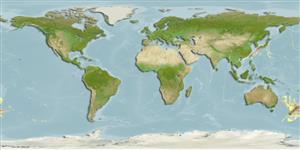Elasmobranchii (sharks and rays) >
Squaliformes (Sleeper and dogfish sharks) >
Somniosidae (Sleeper sharks)
Etymology: Somniosus: Latin for sleepy, reflecting Lesueur’s surmise that these sharks are slow or sluggish because of their relatively small fins (hence the name sleeper sharks) (See ETYFish); longus: Latin for long, perhaps referring to what Tanaka described as its “oblong” shape (See ETYFish).
More on author: Tanaka.
Environment: milieu / climate zone / depth range / distribution range
Ecology
Marine; bathydemersal; depth range 250 - 1160 m (Ref. 50224). Subtropical
Distribution
Countries | FAO areas | Ecosystems | Occurrences | Point map | Introductions | Faunafri
Western Pacific: Japan and New Zealand.
Size / Weight / Age
Maturity: Lm ? range ? - ? cm
Max length : 110 cm TL male/unsexed; (Ref. 50224); 130.1 cm TL (female)
Vertebrae: 77 - 79. Somniosus longus is distinguished from S. rostratus in having a relatively longer second dorsal fin where overall length is almost equal to first dorsal fin 91-100% (vs. 76-88%); slightly larger eye with horizontal diameter more than 37% (mean 46%) of length from snout tip to eye (vs. <37, mean 33%); higher number of tooth rows in upper jaw 56-57 (vs.53); and slightly higher spiral valve counts 26-27 (vs. 23 ) (Ref. 50224).
Caught by crab pot and bottom longline (Ref. 50224).
Life cycle and mating behavior
Maturity | Reproduction | Spawning | Eggs | Fecundity | Larvae
Yano, K., J.D. Stevens and L.J.V. Compagno, 2004. A review of the systematics of the sleeper shark genus Somniosus with redescriptions of Somniosus (Somniosus) antarcticus and Somniosus (Rhinoscymnus) longus (Squaliformes: Somniosidae). Ichthyol. Res. 51:360-373. (Ref. 50224)
IUCN Red List Status (Ref. 130435: Version 2024-1)
Threat to humans
Harmless
Human uses
Tools
Special reports
Download XML
Internet sources
Estimates based on models
Phylogenetic diversity index (Ref.
82804): PD
50 = 0.5313 [Uniqueness, from 0.5 = low to 2.0 = high].
Bayesian length-weight: a=0.00380 (0.00164 - 0.00880), b=3.14 (2.95 - 3.33), in cm total length, based on LWR estimates for this (Sub)family-body shape (Ref.
93245).
Trophic level (Ref.
69278): 4.1 ±0.4 se; based on size and trophs of closest relatives
Fishing Vulnerability (Ref.
59153): Very high vulnerability (78 of 100).
